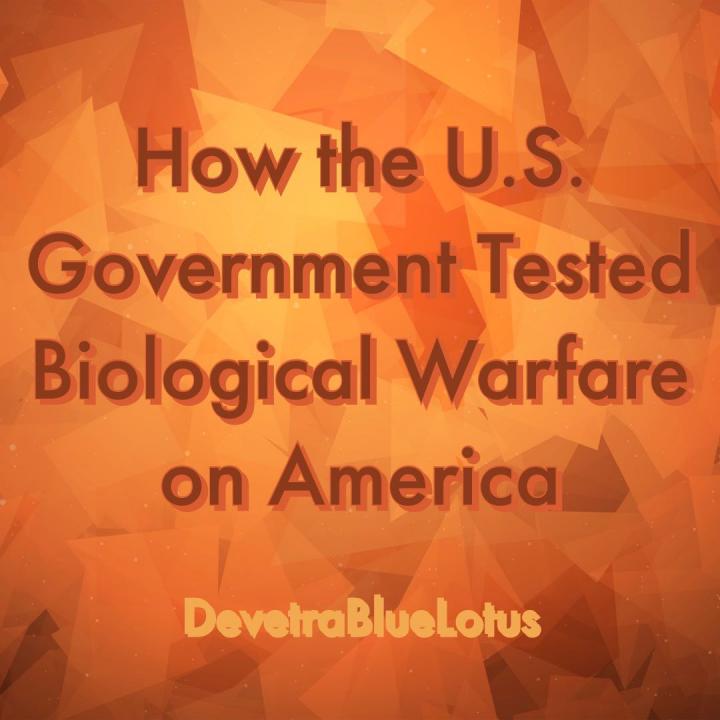HTN SPONSORED BUSINESSES
DONATE TO KEEP THE MOVEMENT GOING
Devetra BlueLotus Nefertiti's Album: Wall Photos
As leaves turned red, and as San Francisco segued into the smoky autumn of 1950, Edward Nevin lay dying in a hospital bed.
A rare bacteria had entered his urinary tract, made its way through his bloodstream, and clung to his heart -- a bacteria that had never been seen in the hospital’s history. Before researchers could hypothesize the bacteria's root cause, ten more patients were admitted with the same infection. Doctors were baffled: how could have this microbe presented itself?
For nearly thirty years, the incident remained a secret -- until Edward Nevin’s grandson set out to bring about justice.
What ensued was a series of terrifying revelations: for two decades, the United States government had intentionally doused 293 populated areas with bacteria. They'd done this with secrecy. They’d done this without informing citizens of potentially dangerous exposure. They’d done this without taking precautions to protect the public’s health and safety, and with no medical follow-up
And it had all started in 1950, with the spraying of San Francisco.
Biological Warfare in the U.S.
Biological warfare, or “germ warfare,” is the “use of biological toxins or infectious agents (bacteria, viruses, and fungi) with the intent to kill or incapacitate humans.” Historically, the United States’ involvement in bacterial weaponry has been driven by competition and paranoia.
In 1918, toward the tail end of World War I, the government briefly experimented with ricin -- a deadly, natural plant protein -- and the Chemical Warfare Service (CWS) was formed to oversee research and development. With the signing of the Geneva Protocol in 1925 (which prohibited the use of biological and chemical weapons in international warfare), the U.S. government’s interest waned: until the 1940s, biological weapons were largely considered impractical.
Shortly after Pearl Harbor, the United States changed its mind.
In 1942, President Roosevelt signed into action the first biological warfare program; backed by the National Academy of Sciences, the initiative sought to develop biological weapons and explore vulnerability of the U.S. to such attacks. A government body -- the War Research Service (WRS) -- was created to oversee these activities, and George W Merck (of the Merck Pharmaceutical Company) was appointed to leadership. At his team’s directive, Fort Detrick, the United States’ biological warfare “headquarters,” was constructed in the small town of of Frederick, Maryland.
The facility then embarked on top secret plan to stage open-air “biological warfare tests” using the unsuspecting American public.
https://priceonomics.com/how-the-us-government-tested-biological-warfare-on/
A rare bacteria had entered his urinary tract, made its way through his bloodstream, and clung to his heart -- a bacteria that had never been seen in the hospital’s history. Before researchers could hypothesize the bacteria's root cause, ten more patients were admitted with the same infection. Doctors were baffled: how could have this microbe presented itself?
For nearly thirty years, the incident remained a secret -- until Edward Nevin’s grandson set out to bring about justice.
What ensued was a series of terrifying revelations: for two decades, the United States government had intentionally doused 293 populated areas with bacteria. They'd done this with secrecy. They’d done this without informing citizens of potentially dangerous exposure. They’d done this without taking precautions to protect the public’s health and safety, and with no medical follow-up
And it had all started in 1950, with the spraying of San Francisco.
Biological Warfare in the U.S.
Biological warfare, or “germ warfare,” is the “use of biological toxins or infectious agents (bacteria, viruses, and fungi) with the intent to kill or incapacitate humans.” Historically, the United States’ involvement in bacterial weaponry has been driven by competition and paranoia.
In 1918, toward the tail end of World War I, the government briefly experimented with ricin -- a deadly, natural plant protein -- and the Chemical Warfare Service (CWS) was formed to oversee research and development. With the signing of the Geneva Protocol in 1925 (which prohibited the use of biological and chemical weapons in international warfare), the U.S. government’s interest waned: until the 1940s, biological weapons were largely considered impractical.
Shortly after Pearl Harbor, the United States changed its mind.
In 1942, President Roosevelt signed into action the first biological warfare program; backed by the National Academy of Sciences, the initiative sought to develop biological weapons and explore vulnerability of the U.S. to such attacks. A government body -- the War Research Service (WRS) -- was created to oversee these activities, and George W Merck (of the Merck Pharmaceutical Company) was appointed to leadership. At his team’s directive, Fort Detrick, the United States’ biological warfare “headquarters,” was constructed in the small town of of Frederick, Maryland.
The facility then embarked on top secret plan to stage open-air “biological warfare tests” using the unsuspecting American public.
https://priceonomics.com/how-the-us-government-tested-biological-warfare-on/



No Stickers to Show